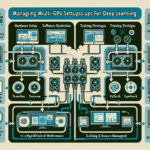Optimizing IT infrastructure for machine learning (ML) workloads requires a strategic approach to ensure performance, scalability, reliability, and cost efficiency. Below is a comprehensive guide tailored to your role as an IT manager responsible for datacenters, storage, servers, virtualization, and other infrastructure components:
1. Assess Workload Requirements
- Understand ML Workloads: Identify the types of workloads (e.g., training, inference, data preprocessing) and their resource demands (compute, memory, storage, and network).
- Frameworks and Tools: Determine which ML frameworks (TensorFlow, PyTorch, etc.) and tools (Kubernetes, Docker, etc.) will be used to optimize compatibility.
- GPU Needs: Machine learning training often relies on GPU acceleration. Assess whether your workloads require high-end GPUs like NVIDIA A100s or consumer-grade GPUs like RTX 4090.
2. Optimize Compute Resources
- Leverage GPUs: Invest in GPUs specifically designed for ML workloads. NVIDIA GPUs with CUDA cores and Tensor cores (e.g., A100, H100) are ideal for training deep learning models.
- Scale with CPUs: For preprocessing and inference workloads, choose high-performance CPUs with a high core count and large cache, such as AMD EPYC or Intel Xeon processors.
- Enable Mixed Precision Training: Use GPUs that support mixed precision to improve training speed without compromising accuracy.
3. Implement Efficient Storage Solutions
- High-Performance Storage: Deploy NVMe SSDs for fast data access during training and inference. Consider storage solutions like Dell PowerScale, NetApp AFF, or Pure Storage arrays for high throughput.
- Tiered Storage: Use tiered storage to optimize costs (e.g., SSD for active datasets, HDD for archived data).
- Parallel File Systems: Implement parallel file systems like Lustre or GPFS to handle large-scale data processing efficiently.
4. Optimize Networking
- Low-Latency Networks: Use high-speed interconnects like InfiniBand or RDMA over Converged Ethernet (RoCE) to minimize network bottlenecks in distributed training.
- Scale-Out Infrastructure: Ensure your network fabric can handle large-scale distributed ML workloads across multiple nodes.
- Dedicated VLANs: Set up isolated VLANs for ML workloads to ensure security and reduce congestion.
5. Virtualization and Containerization
- Kubernetes for ML: Use Kubernetes to orchestrate ML workloads efficiently. Leverage GPU scheduling with tools like NVIDIA Kubernetes Device Plugin.
- Containers: Package ML environments in containers (e.g., Docker) for portability and consistency across environments.
- Resource Allocation: Use Kubernetes resource quotas and limits to allocate resources properly and avoid overprovisioning.
6. Leverage AI-Specific Infrastructure
- AI Accelerators: Consider hardware accelerators such as TPUs (Tensor Processing Units) or FPGAs for specific AI workloads.
- Pre-Configured AI Appliances: Deploy pre-configured solutions like NVIDIA DGX systems or Dell EMC Ready Solutions for AI.
7. Optimize Backup and Data Management
- Regular Backups: Implement robust backup solutions for datasets, models, and configurations. Use tools like Veeam, Rubrik, or Commvault for automated backups.
- Data Versioning: Use tools like DVC (Data Version Control) to version control datasets and models.
- Disaster Recovery: Create a disaster recovery plan that ensures minimal downtime for critical ML workflows.
8. Monitor and Manage Performance
- Performance Monitoring: Use tools like Prometheus, Grafana, or DCIM (Data Center Infrastructure Management) software to monitor infrastructure utilization.
- Optimize Workflows: Continuously analyze workloads and optimize pipelines for bottlenecks (e.g., data loading, preprocessing, or training).
- Autoscaling: Configure autoscaling for compute resources in Kubernetes to handle workload spikes dynamically.
9. Ensure Security and Compliance
- Data Encryption: Encrypt sensitive datasets both at rest and in transit using AES-256 or TLS protocols.
- Access Control: Implement strict access controls using IAM (Identity and Access Management) tools.
- Compliance: Ensure infrastructure meets regulatory standards like GDPR or HIPAA if applicable.
10. Explore Cloud and Hybrid Approaches
- Cloud for Scale: Use cloud platforms (AWS, Google Cloud, Azure) for on-demand scalability and specialized AI services like Amazon SageMaker or Google Vertex AI.
- Hybrid Cloud: Combine on-premises datacenter with public cloud for flexibility and cost savings. Use solutions like VMware Cloud or Nutanix for hybrid orchestration.
- Spot Instances: Utilize cloud spot instances for cost-effective training when workloads are not time-sensitive.
11. Optimize for Cost Efficiency
- Reserved Instances: For predictable workloads, reserve cloud instances to reduce costs.
- Energy Efficiency: Use energy-efficient hardware and optimize cooling in datacenters to lower power consumption.
- Consolidate Resources: Consolidate underutilized resources using virtualization or containerization.
12. Collaboration and Training
- Support Data Scientists: Provide them with tools and resources to streamline workflows, such as Jupyter Notebooks, VS Code, or cloud-based ML platforms.
- Training: Ensure your team is trained on ML technologies, hardware optimizations, and cloud platforms.
By implementing these strategies, you’ll be able to create an optimized IT infrastructure that can handle the demands of machine learning workloads while remaining cost-efficient, scalable, and secure.

